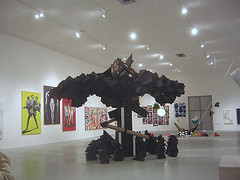
Untitled (New Totems) by Jonathan Prull with Ivanny Pagan’s Foundation to left in back, plus more from the 2006 Penn MFA installation at the Ice Box Project Room at the Crane Art Center
A recent evening’s sampling of cultural events revealed a telling rift in the arts scene here in the City of Brotherly Love.
My first stop was the University of Pennsylvania’s MFA thesis show (see our posts here and here). The event was a lavish affair, filling several rooms of the very hip Crane Arts Building in Fishtown—including the gigantic Ice Box project room. Selection of the work by ICA senior curator Ingrid Schaffner added a conceptual bent to the show, de-emphasizing medium (different types of work were juxtaposed). There were plenty of examples collaborative work and anti-art gestures—notably a group project in which each artist was asked to write a half-phony “artist statement”.
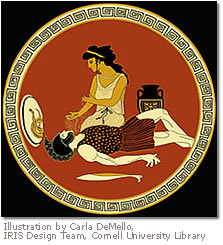
Antigone
Later that evening of the MFA opening I was also invited to attend a play entitled “Testament,” sponsored by the Village of Arts and Humanities. The performance took place at Temple University, and I was surprised to learn that Temple and the Crane building were only about 10 blocks from each other. Yet the two events couldn’t have been further away from one another–in temperament, racial makeup, and overall world view.
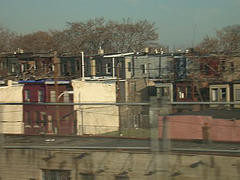
a view of North Philadelphia
The Village of Arts and Humanities is a 20 year-old grass-roots North Philly organization dedicated to improving life in that neighborhood. It started as a project to reclaim vacant land and developed into a respected cultural institution that presents performances, exhibitions and other events as well as creating park lands in empty lots. The Village is now funded by a number of foundations and corporations, as well as individual donors.
Testament was an interpretation of the Greek tragedy “Antigone,” directed by Rodney Gilbert. Its writer, Kumani Gantt, made a deliberate effort to infuse neighborhood culture into this old warhorse of a play—casting a neighborhood teenager as the protagonist and a group of elderly Black women as the chorus.
Like the MFA show, Testament had a conceptual bent, blurring notions of authorship by having the actors write their own lines. Much of this writing was done through a “story circle” conducted with the elders. But where the work in the MFA show was cool and ironic, the play was painfully earnest. The need to find a redemptive message sometimes overwhelmed the framework of the play itself, with the characters breaking out into soap box speeches about perseverance in the face of harsh North Philly realities—drugs, violence, poverty, racism, and lousy schools. And the desire to show different generations coming together harmoniously caused the play to paper over obvious clashes of culture (hip-hop youth and elderly women all starring in a lugubrious Greek drama) that might have been exploited to humorous effect.
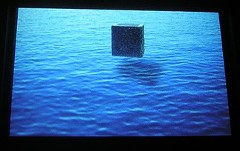
shot from video of The Phantom Limb, by Penn MFA Brent Wahl
Artists in the MFA show were generally not hampered by the need to find a redemptive message. The work they created was smart and sophisticated—ready for Chelsea, or at least Williamsburg. And their decision to hold their show in Fishtown, the rising star of art neighborhoods in Philadelphia, was a bold one. Rather than leaving their artistic baby in the home turf of the academic world, they put it in play in the art world.
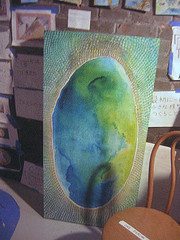
a cityscape by Penn MFA Tadashi Moriyama
But where is that art world located? From the MFA students’ point of view, it’s in Fishtown—and Chelsea, and Williamsburg, and other places in America where there are industrial buildings ready for use. From the point of view of the players in Testament, it’s in North Philly. This is where they, and their parents and grandparents (the “elders”) grew up. This is where they used to work, when there were industrial jobs in the city. So whose world is it?
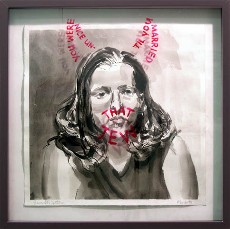
Marybeth, a portrait by Epstein of his wife, from the series, Insult to Injury; the words read, “You were nice until you married that Jew;”
Artists have always been at the core of arguments about gentrification. Depending on your point of view, they’re either giving new hope to residents by offering a shtikl of culture, or spurring a vicious cycle of rising rents (while promoting their own careers). What gets lost in these arguments is the potential for real interaction between artists and their neighbors. Artists tend not to be seen as residents so much as sojourners—people who stay a while and then depart for greener pastures when they see greater success. The loss of interaction between artist and community is perhaps one more form of the “commodity fetish” (the alienation of product and producer) that results in a hardening of class divisions. It has an aesthetic downside as well as a socioeconomic one. Without a real sense of who they are and where they belong, artists can easily become soulless clones—producing work that is sophisticated but meaningless. Conversely, without the mouthpiece of aesthetic sophistication, the voices of those who live in neighborhoods like North Philly will likely go unheard. What is needed is for these two communities to somehow get together.
–Artist Edward M. Epstein is coordinator, 40th St. Artist-in-Residence Program









